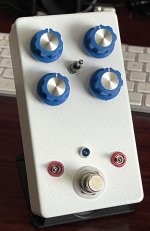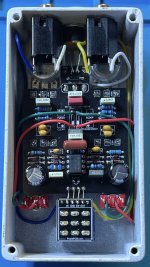MichaelW
Well-known member
Pedal #2 for today......
I've been on a roll with building the Kingtone line of pedals lately (King's Hand V1 & V2, Lone King) so I decided to round out the collection with the Blues Power.
I didn't know much about it until recently when I read the AionFX write up and trace journal. I found it pretty interesting that they tried to throw the DIY community off the trail with some bone headed moves, like the fake transistor and the extra diodes that don't do anything. I forgot about that last part, or I would have probably not wasted 4 1N4148's in this build. Anyway, they're in there although I'm not sure if they actually do anything.
So essentially this is a Timmy clone with some slight mods. However, I don't think it sounds very close to the Timmy. One of the reasons I like the KingTone line of pedals is that they sound "fatter" and "thicker" than the circuits that they are based one. (King's Hand is based on a BluesBreaker, Lone King is based on a TS and the Blues Power is based on the Timmy).
I put it side by side with my Tommy III (Timmy v3) they sound like different pedals. I like them both but I think I like the Powder Blue a bit more for the reasons stated above (fatter, thicker, meatier). I would not really consider either the Timmy or the Blues Power "transparent" as far as my understanding of what that's supposed to mean. I think the Mach 1 (Greer Lightspeed) and the Seashore (Low Tide Seafoam) are more "transparent" in that the tone and character of the clean guitar is better preserved when overdriven.
There's also quite a bit of gain available for them to be boxed in the "low gain" category, (The Timmy has a high gain setting and the Powder Blue natively has more gain).
But they do seem to sound the best with the gain below or around 12 0'clock. The Powder Blue retains the Blues Power's "Edge-Stock-Glass" eq settings on a toggle and has a dual internal dip switch that shapes the midrange contour. I wound up exposing those dip switches as mini toggles but the effect is quite subtle. Still worth doing though. Just more options to tailor the pedal to the particular guitar and amp.
This project had some oddball capacitor values that I didn't want to place a special order for, so there's a veritable orgy of copulating capacitors in this build
One final tidbit is that this was a "repurposed" enclosure. This was actually the last pedal that I bought before starting DIY. I got it off Reverb and it originally had a PedalPCB Mayahana board in it. It was this pedal that when I opened it up and saw the PCB with the website silkscreened on it that led me to find the pedalpcb.com website and kickstarted my DIY obsession. I also thought that the the Mayahana PCB looked so tiny inside the 125B enclosure that I re-housed that pedal in a 1590B. Since then, I've been looking for a project that had the same drill pattern so that I could re-use the enclosure. So now, I'm about 60 pedals into my DIY career and there's a sense of coming full circle in being able to re-use this enclosure that started it all for me. (The builder was probably one of you guys hahaha!).
Anyway, another great flavor of low gain overdrive to add to my collection. I have one more project on deck that I hope to have buttoned up by tomorrow.
Then after that my buddy wants me to build him a reverb and delay pedal for his acoustic rig. I just ordered another set of Gravitation and Magnetron boards for him.
He wants them both in a single enclosure but I'm not really sure if that's doable with the standard sized enclosures given the size of the boards. Mulling over what my options are but that's another project for another day


I've been on a roll with building the Kingtone line of pedals lately (King's Hand V1 & V2, Lone King) so I decided to round out the collection with the Blues Power.
I didn't know much about it until recently when I read the AionFX write up and trace journal. I found it pretty interesting that they tried to throw the DIY community off the trail with some bone headed moves, like the fake transistor and the extra diodes that don't do anything. I forgot about that last part, or I would have probably not wasted 4 1N4148's in this build. Anyway, they're in there although I'm not sure if they actually do anything.
So essentially this is a Timmy clone with some slight mods. However, I don't think it sounds very close to the Timmy. One of the reasons I like the KingTone line of pedals is that they sound "fatter" and "thicker" than the circuits that they are based one. (King's Hand is based on a BluesBreaker, Lone King is based on a TS and the Blues Power is based on the Timmy).
I put it side by side with my Tommy III (Timmy v3) they sound like different pedals. I like them both but I think I like the Powder Blue a bit more for the reasons stated above (fatter, thicker, meatier). I would not really consider either the Timmy or the Blues Power "transparent" as far as my understanding of what that's supposed to mean. I think the Mach 1 (Greer Lightspeed) and the Seashore (Low Tide Seafoam) are more "transparent" in that the tone and character of the clean guitar is better preserved when overdriven.
There's also quite a bit of gain available for them to be boxed in the "low gain" category, (The Timmy has a high gain setting and the Powder Blue natively has more gain).
But they do seem to sound the best with the gain below or around 12 0'clock. The Powder Blue retains the Blues Power's "Edge-Stock-Glass" eq settings on a toggle and has a dual internal dip switch that shapes the midrange contour. I wound up exposing those dip switches as mini toggles but the effect is quite subtle. Still worth doing though. Just more options to tailor the pedal to the particular guitar and amp.
This project had some oddball capacitor values that I didn't want to place a special order for, so there's a veritable orgy of copulating capacitors in this build
One final tidbit is that this was a "repurposed" enclosure. This was actually the last pedal that I bought before starting DIY. I got it off Reverb and it originally had a PedalPCB Mayahana board in it. It was this pedal that when I opened it up and saw the PCB with the website silkscreened on it that led me to find the pedalpcb.com website and kickstarted my DIY obsession. I also thought that the the Mayahana PCB looked so tiny inside the 125B enclosure that I re-housed that pedal in a 1590B. Since then, I've been looking for a project that had the same drill pattern so that I could re-use the enclosure. So now, I'm about 60 pedals into my DIY career and there's a sense of coming full circle in being able to re-use this enclosure that started it all for me. (The builder was probably one of you guys hahaha!).
Anyway, another great flavor of low gain overdrive to add to my collection. I have one more project on deck that I hope to have buttoned up by tomorrow.
Then after that my buddy wants me to build him a reverb and delay pedal for his acoustic rig. I just ordered another set of Gravitation and Magnetron boards for him.
He wants them both in a single enclosure but I'm not really sure if that's doable with the standard sized enclosures given the size of the boards. Mulling over what my options are but that's another project for another day



